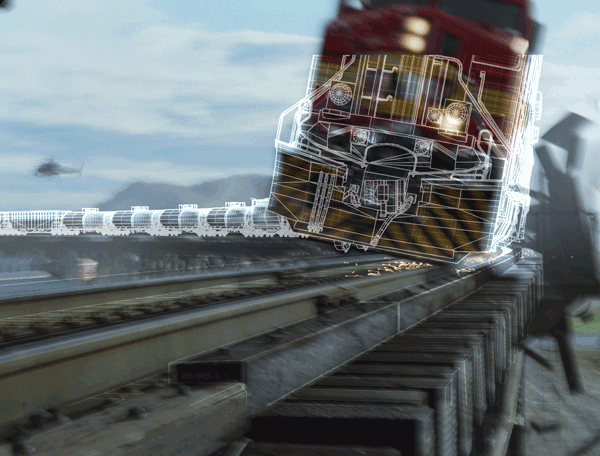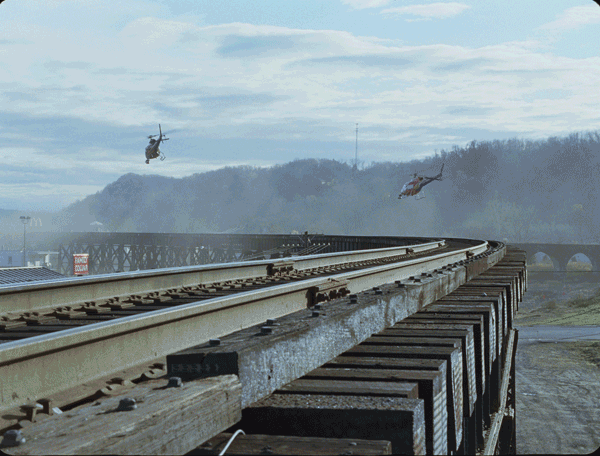Asylum VFX provides nifty invisible CG for Tony Scott's latest thrill ride.
Check out the Unstoppable trailer at AWNtv!
Inspired by a true story, a runaway train carrying a cargo of toxic chemicals pits an engineer (Denzel Washington) and a conductor (Chris Pine) in a race against time before it derails and destroys a Pennsylvania town.
"This is not a visual effects movie," emphasizes Nathan McGuinness of Asylum VFX, a long-time collaborator with director Tony Scott, who nonetheless supervised the vfx with Asylum colleague Paul O'Shea.
"Tony definitely tries to do everything he can in camera and he will take that to the extreme, which poses challenges for us," McGuinness suggests. "I'm always trying to figure out solutions to not doing visual effects, which is bizarre. So what I have to do is be a supporter of Tony's rather than a problem solver trying to fix it in post using visual effects. And then when I have to I'm under immense pressure to make sure that it matches the photography so it doesn't look like visual effects.
"The challenge was dealing with these trains, which were the third character in this film, and give the impression that this was a non-stop thrill ride from start to finish. From the moment the 777 becomes an un-manned vehicle, it becomes its own creature. With photography and Tony's great visual skill, we were able to make the trains run at a much faster rate than what we were capturing in real life. It makes the audience feel that they are really watching a runaway train."
Indeed, aside from the actors, the main character of the film is a train: two large engines and 25 train cars, out-of-control and speeding toward an inevitable disaster. It is a simple premise, but as a film it begs to be a gritty and unquestionably real experience.
"The long and short of it is that we knew we were going to have to build a CG train," McGuinness admits. "We modeled, textured, lit and animated a photoreal CG 777. Even if Tony wanted a 2D train there were instances when we couldn't manipulate the photography as such; in some cases the train had to go off the rails and we couldn't always do that in 2D so we had to be prepared with a 3D back-up plan."
There were a wide variety of 2D and 3D shots: Replacing the undercarriages of flipping cars, removing camera and crew reflections, adding flying debris, enhancing huge explosions, flatbed removal and often replacement of entire portions of the train as it sped along (behind a blur of organic and man-made structures). But the most crucial and most prominently featured challenges had to do with the faithful recreation of the speeding train and the danger that lay ahead.
"Because the 777 plows through several objects throughout the film, the front end of the engine gets progressively damaged throughout." McGuinness continues. "While on set we photographed and surveyed the four phases of the damaged engine so we could model and texture each phase of the damage. Once the cut was done, we had to go through quite a few shots and replace the front end of the train with the right stages of damage."
In addition, not only were there speed restrictions on how fast the train could go, but they couldn't have two trains on the same section of track when shooting. "So what we decided to do is put a flatbed truck between the back of the chasing blue locomotive that Denzel is in and the back of the runaway train," explains O'Shea. "By having those together, we shot helicopter shots and shot from the tops of the trains and then we'd have to remove the flatbed that was holding them and then animate the trains to move closer together or farther apart or to reconstitute the parts of the train that are obscured by having this flatbed."
Since it was unclear which shots would require a CG train (and what details would be visible and from what angles), each car was carefully measured and photographed. The resulting models were constructed in Maya. The resolution had to also hold up from a mile away as well as from a few feet. Tools were generated to quickly build tracks and animate trains based on survey and tracking information.
Thus, with such attention given early in the process, most initial renders integrated very well with plates based on the lighting data that it had been possible to acquire. But, it hadn't been possible (within the production schedule) to acquire the detailed lighting data required to accurately illuminate every point along the train as it moved through varying lighting conditions. So, where needed using the available survey and lighting information, (and available reference as a guide) environment representations were constructed in 3D and incorporated as the trains were rendered in PRMan in order to lend local detail to the reflections and indirect diffuse. This allowed for more natural lighting interaction as each point along the quarter-mile length of the train reflects its own unique view of the world around it. Attention was given to the slightest bumps and defects along the varied surfaces to ensure that the rendered result was indistinguishable from reference.
Since there was no refinery present in the area around the Stanton Curve in the movie, this would also need to be created in CG. The refinery, with its 20 large tanks fitted with hundreds of pipes, catwalks, guardrails, vents and related details, and the surrounding fences and assorted props, needed to be rendered in each shot. Rendered for scenes from all hours of the day and from all conceivable angles (seen from different vantage points), the integration needed to be flawless. Detailed survey data was used to construct a virtual environment into which the refinery was built. For each component of the 3D environment, highly detailed models and textures were generated to accommodate the viewing requirements.
Again, models were constructed in Maya and textures painted in Photoshop. Starting from a small footprint, the refinery nearly doubled in size to accommodate the requirements of specific shots and angles, pressing into the corners where tracks converge and even threatening to envelope the road. Lit in PRMan using HDRI and incorporating global illumination to accurately reflect specular and the subtle bleed of diffuse illumination, the tanks were fit seamlessly into the world of the Stanton Curve.
The final effect, according to O'Shea, "allowed Tony to have as much real photography in the frame and that's what he judges things by."
Bill Desowitz is senior editor of AWN & VFXWorld.











